Accounting Fundamentals: Wales Plc Financial Statement Analysis Report
VerifiedAdded on 2023/01/09
|11
|3064
|82
Report
AI Summary
This comprehensive report delves into the core principles of accounting, providing a detailed analysis of financial statements, including the income statement and balance sheet. The report demonstrates the preparation of these statements using provided trial balance data for Wales Plc. Furthermore, it explores the calculation and interpretation of various financial ratios, offering insights into the performance of Jerry Plc across different periods. The report also identifies and discusses the interests of different user groups of company accounts, such as internal and external stakeholders, and evaluates the advantages and disadvantages of a highly regulated financial reporting regime. Finally, the report examines the limitations of financial statements, providing a well-rounded understanding of accounting fundamentals and their practical applications.
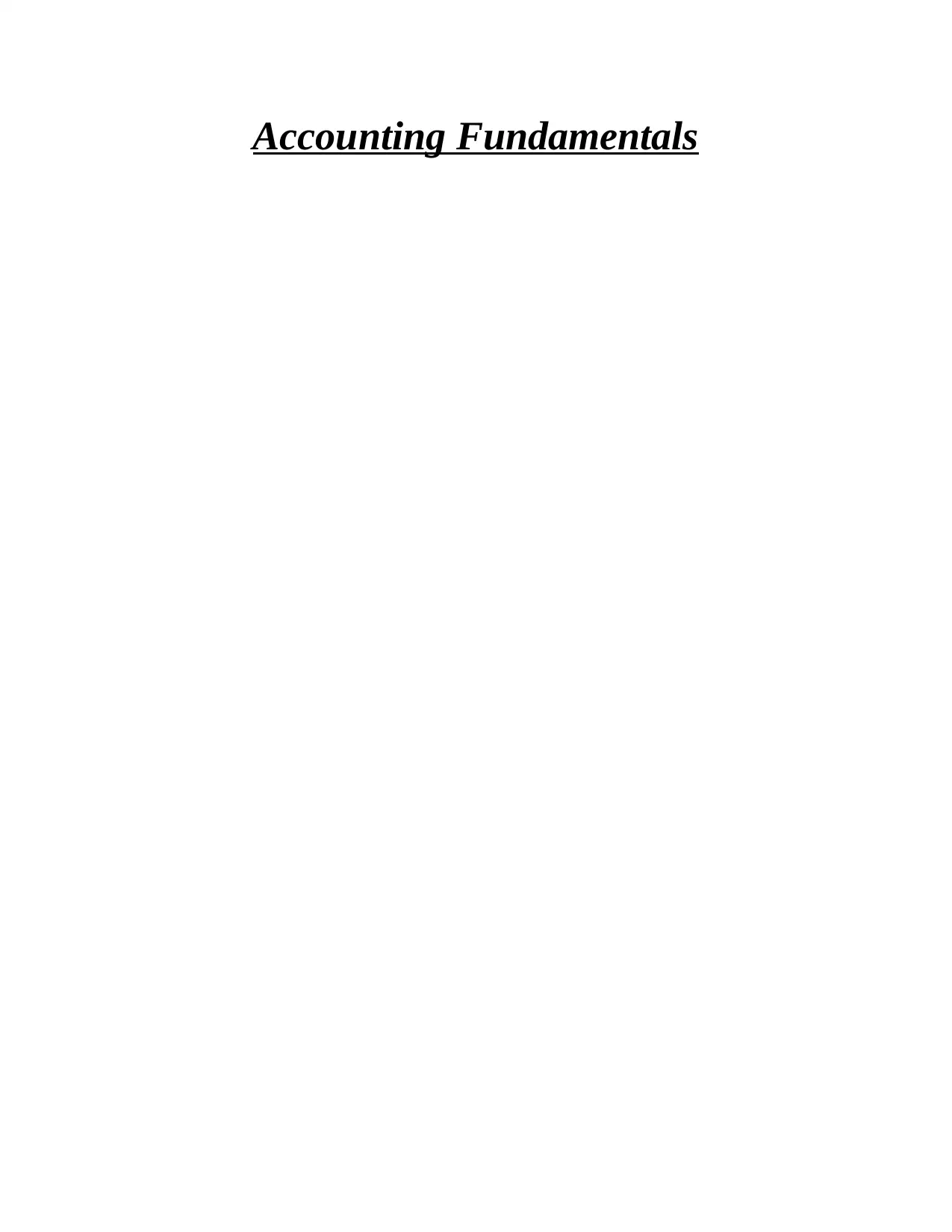
Accounting Fundamentals
Paraphrase This Document
Need a fresh take? Get an instant paraphrase of this document with our AI Paraphraser
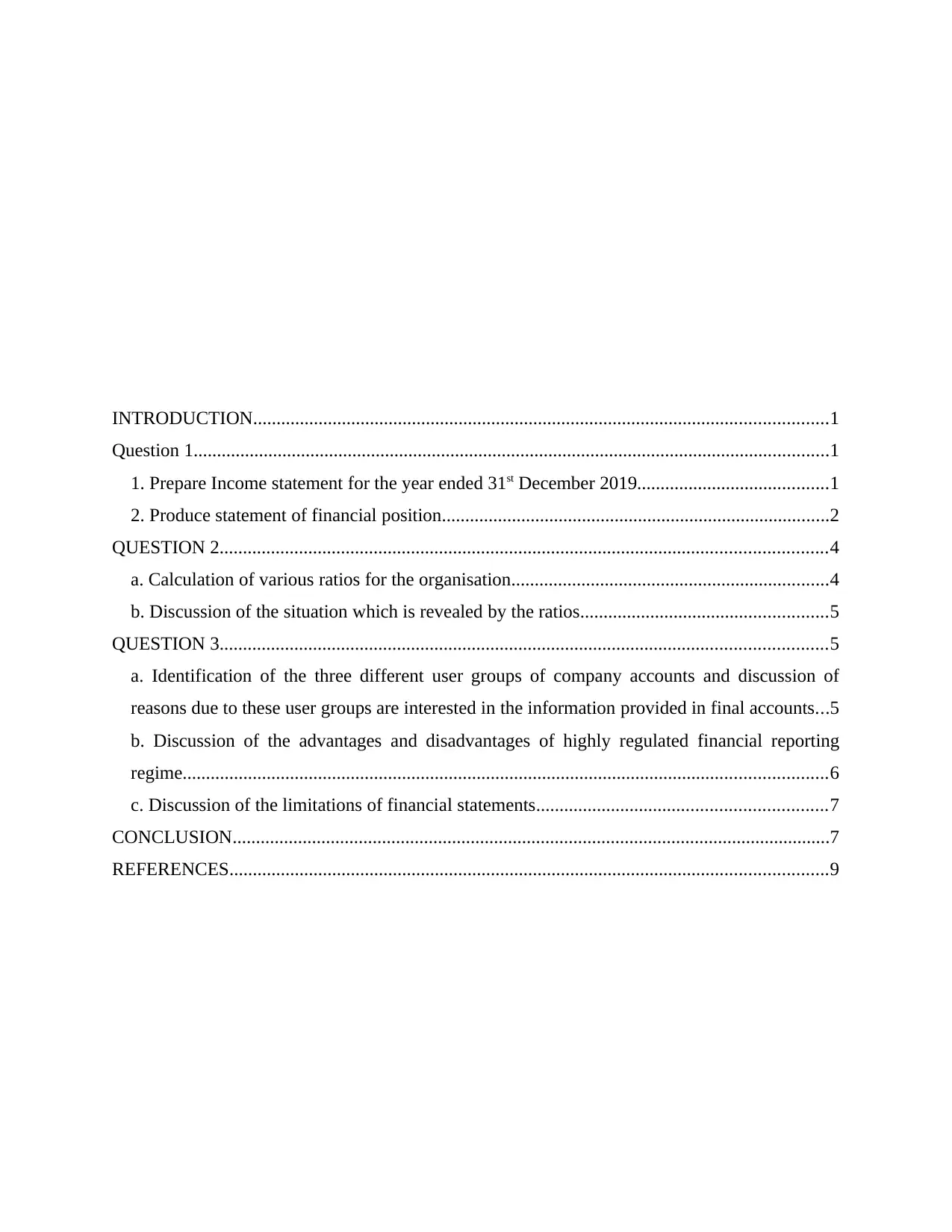
INTRODUCTION...........................................................................................................................1
Question 1........................................................................................................................................1
1. Prepare Income statement for the year ended 31st December 2019.........................................1
2. Produce statement of financial position...................................................................................2
QUESTION 2..................................................................................................................................4
a. Calculation of various ratios for the organisation....................................................................4
b. Discussion of the situation which is revealed by the ratios.....................................................5
QUESTION 3..................................................................................................................................5
a. Identification of the three different user groups of company accounts and discussion of
reasons due to these user groups are interested in the information provided in final accounts...5
b. Discussion of the advantages and disadvantages of highly regulated financial reporting
regime..........................................................................................................................................6
c. Discussion of the limitations of financial statements..............................................................7
CONCLUSION................................................................................................................................7
REFERENCES................................................................................................................................9
Question 1........................................................................................................................................1
1. Prepare Income statement for the year ended 31st December 2019.........................................1
2. Produce statement of financial position...................................................................................2
QUESTION 2..................................................................................................................................4
a. Calculation of various ratios for the organisation....................................................................4
b. Discussion of the situation which is revealed by the ratios.....................................................5
QUESTION 3..................................................................................................................................5
a. Identification of the three different user groups of company accounts and discussion of
reasons due to these user groups are interested in the information provided in final accounts...5
b. Discussion of the advantages and disadvantages of highly regulated financial reporting
regime..........................................................................................................................................6
c. Discussion of the limitations of financial statements..............................................................7
CONCLUSION................................................................................................................................7
REFERENCES................................................................................................................................9
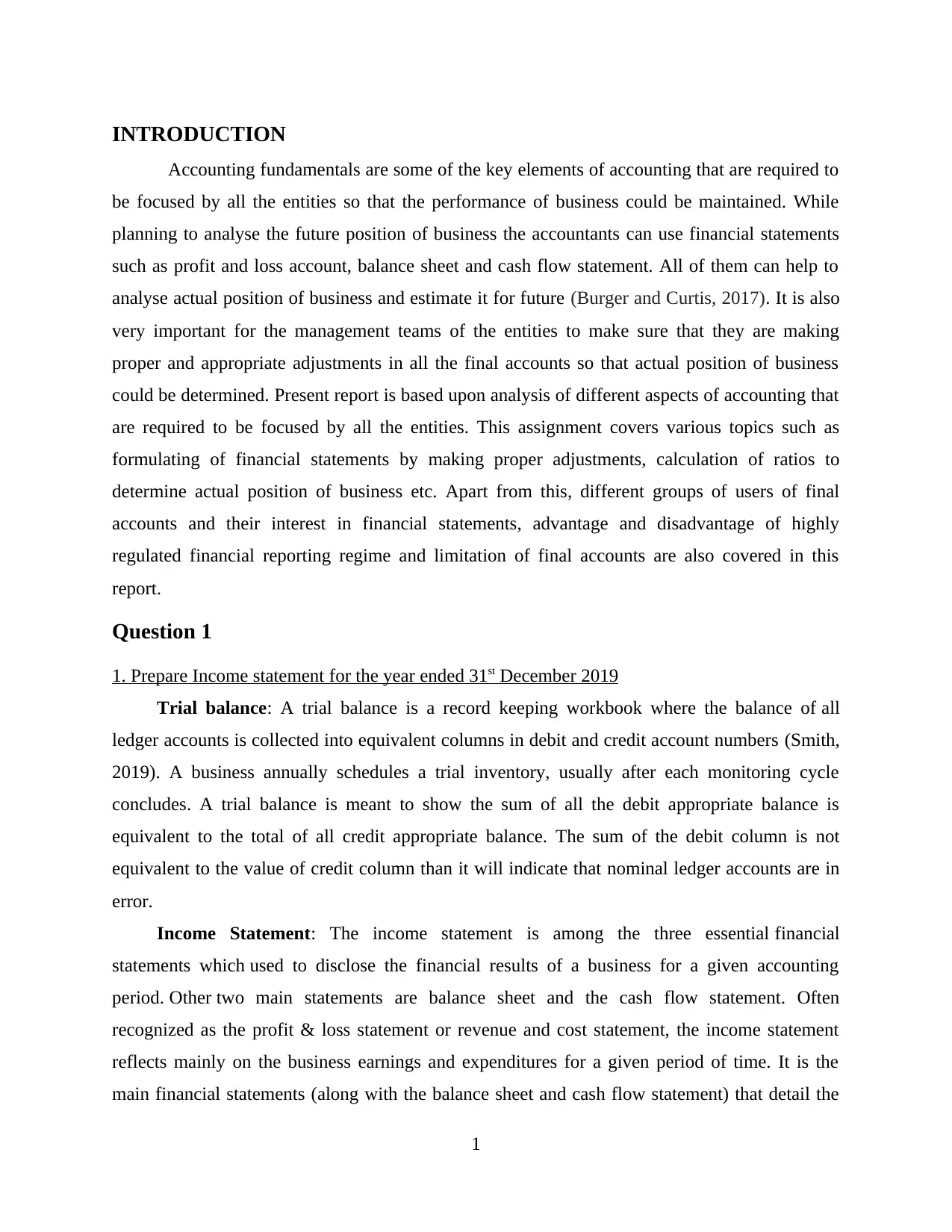
INTRODUCTION
Accounting fundamentals are some of the key elements of accounting that are required to
be focused by all the entities so that the performance of business could be maintained. While
planning to analyse the future position of business the accountants can use financial statements
such as profit and loss account, balance sheet and cash flow statement. All of them can help to
analyse actual position of business and estimate it for future (Burger and Curtis, 2017). It is also
very important for the management teams of the entities to make sure that they are making
proper and appropriate adjustments in all the final accounts so that actual position of business
could be determined. Present report is based upon analysis of different aspects of accounting that
are required to be focused by all the entities. This assignment covers various topics such as
formulating of financial statements by making proper adjustments, calculation of ratios to
determine actual position of business etc. Apart from this, different groups of users of final
accounts and their interest in financial statements, advantage and disadvantage of highly
regulated financial reporting regime and limitation of final accounts are also covered in this
report.
Question 1
1. Prepare Income statement for the year ended 31st December 2019
Trial balance: A trial balance is a record keeping workbook where the balance of all
ledger accounts is collected into equivalent columns in debit and credit account numbers (Smith,
2019). A business annually schedules a trial inventory, usually after each monitoring cycle
concludes. A trial balance is meant to show the sum of all the debit appropriate balance is
equivalent to the total of all credit appropriate balance. The sum of the debit column is not
equivalent to the value of credit column than it will indicate that nominal ledger accounts are in
error.
Income Statement: The income statement is among the three essential financial
statements which used to disclose the financial results of a business for a given accounting
period. Other two main statements are balance sheet and the cash flow statement. Often
recognized as the profit & loss statement or revenue and cost statement, the income statement
reflects mainly on the business earnings and expenditures for a given period of time. It is the
main financial statements (along with the balance sheet and cash flow statement) that detail the
1
Accounting fundamentals are some of the key elements of accounting that are required to
be focused by all the entities so that the performance of business could be maintained. While
planning to analyse the future position of business the accountants can use financial statements
such as profit and loss account, balance sheet and cash flow statement. All of them can help to
analyse actual position of business and estimate it for future (Burger and Curtis, 2017). It is also
very important for the management teams of the entities to make sure that they are making
proper and appropriate adjustments in all the final accounts so that actual position of business
could be determined. Present report is based upon analysis of different aspects of accounting that
are required to be focused by all the entities. This assignment covers various topics such as
formulating of financial statements by making proper adjustments, calculation of ratios to
determine actual position of business etc. Apart from this, different groups of users of final
accounts and their interest in financial statements, advantage and disadvantage of highly
regulated financial reporting regime and limitation of final accounts are also covered in this
report.
Question 1
1. Prepare Income statement for the year ended 31st December 2019
Trial balance: A trial balance is a record keeping workbook where the balance of all
ledger accounts is collected into equivalent columns in debit and credit account numbers (Smith,
2019). A business annually schedules a trial inventory, usually after each monitoring cycle
concludes. A trial balance is meant to show the sum of all the debit appropriate balance is
equivalent to the total of all credit appropriate balance. The sum of the debit column is not
equivalent to the value of credit column than it will indicate that nominal ledger accounts are in
error.
Income Statement: The income statement is among the three essential financial
statements which used to disclose the financial results of a business for a given accounting
period. Other two main statements are balance sheet and the cash flow statement. Often
recognized as the profit & loss statement or revenue and cost statement, the income statement
reflects mainly on the business earnings and expenditures for a given period of time. It is the
main financial statements (along with the balance sheet and cash flow statement) that detail the
1
⊘ This is a preview!⊘
Do you want full access?
Subscribe today to unlock all pages.

Trusted by 1+ million students worldwide
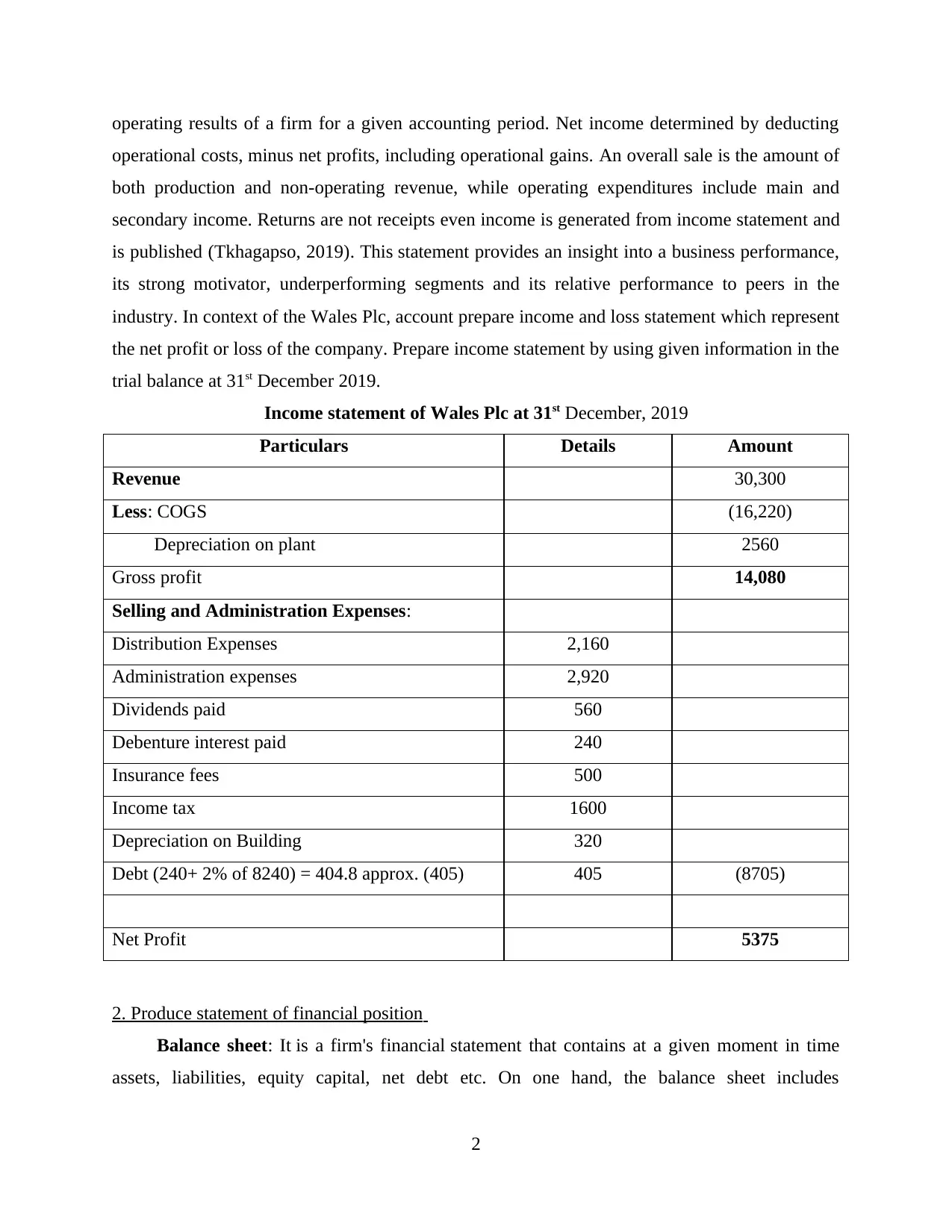
operating results of a firm for a given accounting period. Net income determined by deducting
operational costs, minus net profits, including operational gains. An overall sale is the amount of
both production and non-operating revenue, while operating expenditures include main and
secondary income. Returns are not receipts even income is generated from income statement and
is published (Tkhagapso, 2019). This statement provides an insight into a business performance,
its strong motivator, underperforming segments and its relative performance to peers in the
industry. In context of the Wales Plc, account prepare income and loss statement which represent
the net profit or loss of the company. Prepare income statement by using given information in the
trial balance at 31st December 2019.
Income statement of Wales Plc at 31st December, 2019
Particulars Details Amount
Revenue 30,300
Less: COGS (16,220)
Depreciation on plant 2560
Gross profit 14,080
Selling and Administration Expenses:
Distribution Expenses 2,160
Administration expenses 2,920
Dividends paid 560
Debenture interest paid 240
Insurance fees 500
Income tax 1600
Depreciation on Building 320
Debt (240+ 2% of 8240) = 404.8 approx. (405) 405 (8705)
Net Profit 5375
2. Produce statement of financial position
Balance sheet: It is a firm's financial statement that contains at a given moment in time
assets, liabilities, equity capital, net debt etc. On one hand, the balance sheet includes
2
operational costs, minus net profits, including operational gains. An overall sale is the amount of
both production and non-operating revenue, while operating expenditures include main and
secondary income. Returns are not receipts even income is generated from income statement and
is published (Tkhagapso, 2019). This statement provides an insight into a business performance,
its strong motivator, underperforming segments and its relative performance to peers in the
industry. In context of the Wales Plc, account prepare income and loss statement which represent
the net profit or loss of the company. Prepare income statement by using given information in the
trial balance at 31st December 2019.
Income statement of Wales Plc at 31st December, 2019
Particulars Details Amount
Revenue 30,300
Less: COGS (16,220)
Depreciation on plant 2560
Gross profit 14,080
Selling and Administration Expenses:
Distribution Expenses 2,160
Administration expenses 2,920
Dividends paid 560
Debenture interest paid 240
Insurance fees 500
Income tax 1600
Depreciation on Building 320
Debt (240+ 2% of 8240) = 404.8 approx. (405) 405 (8705)
Net Profit 5375
2. Produce statement of financial position
Balance sheet: It is a firm's financial statement that contains at a given moment in time
assets, liabilities, equity capital, net debt etc. On one hand, the balance sheet includes
2
Paraphrase This Document
Need a fresh take? Get an instant paraphrase of this document with our AI Paraphraser
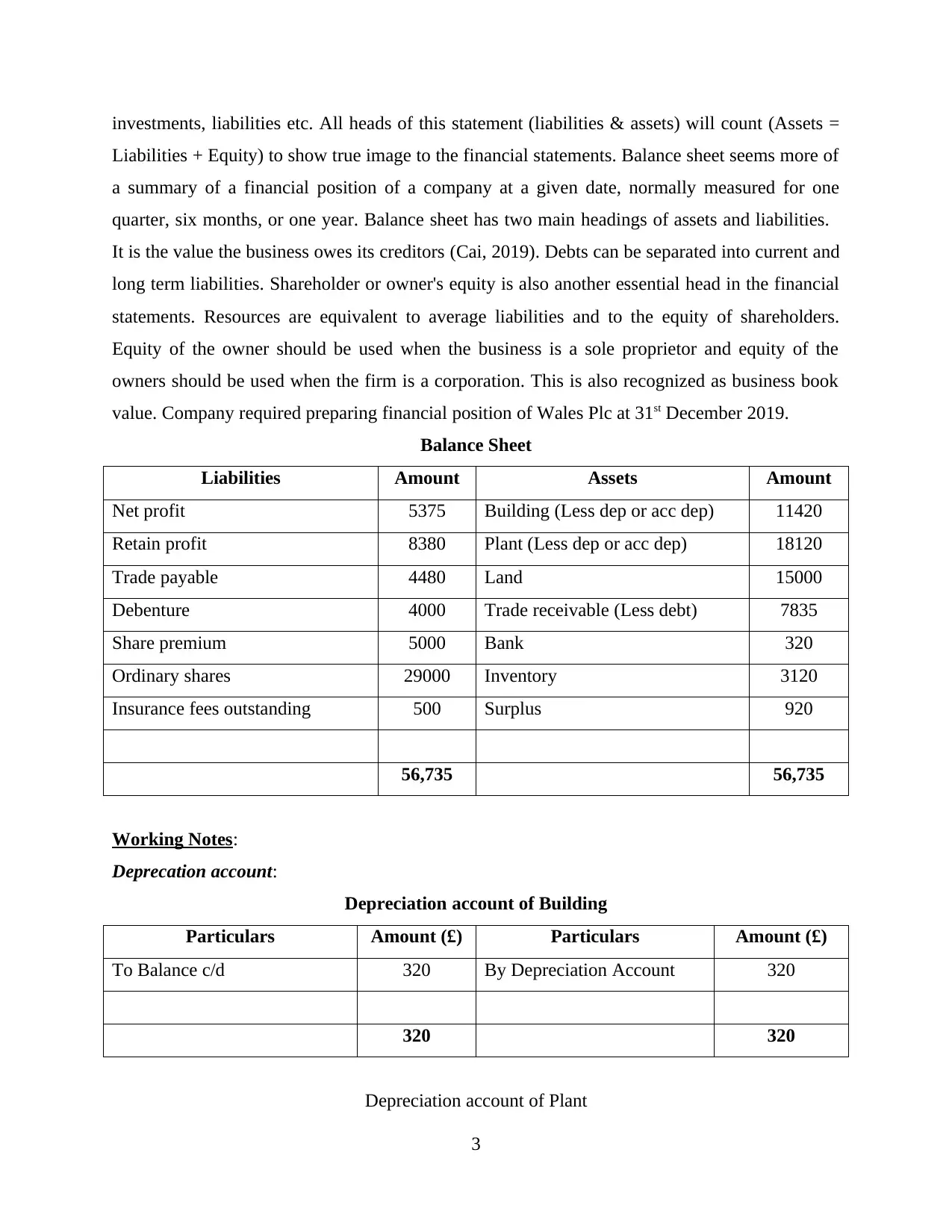
investments, liabilities etc. All heads of this statement (liabilities & assets) will count (Assets =
Liabilities + Equity) to show true image to the financial statements. Balance sheet seems more of
a summary of a financial position of a company at a given date, normally measured for one
quarter, six months, or one year. Balance sheet has two main headings of assets and liabilities.
It is the value the business owes its creditors (Cai, 2019). Debts can be separated into current and
long term liabilities. Shareholder or owner's equity is also another essential head in the financial
statements. Resources are equivalent to average liabilities and to the equity of shareholders.
Equity of the owner should be used when the business is a sole proprietor and equity of the
owners should be used when the firm is a corporation. This is also recognized as business book
value. Company required preparing financial position of Wales Plc at 31st December 2019.
Balance Sheet
Liabilities Amount Assets Amount
Net profit 5375 Building (Less dep or acc dep) 11420
Retain profit 8380 Plant (Less dep or acc dep) 18120
Trade payable 4480 Land 15000
Debenture 4000 Trade receivable (Less debt) 7835
Share premium 5000 Bank 320
Ordinary shares 29000 Inventory 3120
Insurance fees outstanding 500 Surplus 920
56,735 56,735
Working Notes:
Deprecation account:
Depreciation account of Building
Particulars Amount (£) Particulars Amount (£)
To Balance c/d 320 By Depreciation Account 320
320 320
Depreciation account of Plant
3
Liabilities + Equity) to show true image to the financial statements. Balance sheet seems more of
a summary of a financial position of a company at a given date, normally measured for one
quarter, six months, or one year. Balance sheet has two main headings of assets and liabilities.
It is the value the business owes its creditors (Cai, 2019). Debts can be separated into current and
long term liabilities. Shareholder or owner's equity is also another essential head in the financial
statements. Resources are equivalent to average liabilities and to the equity of shareholders.
Equity of the owner should be used when the business is a sole proprietor and equity of the
owners should be used when the firm is a corporation. This is also recognized as business book
value. Company required preparing financial position of Wales Plc at 31st December 2019.
Balance Sheet
Liabilities Amount Assets Amount
Net profit 5375 Building (Less dep or acc dep) 11420
Retain profit 8380 Plant (Less dep or acc dep) 18120
Trade payable 4480 Land 15000
Debenture 4000 Trade receivable (Less debt) 7835
Share premium 5000 Bank 320
Ordinary shares 29000 Inventory 3120
Insurance fees outstanding 500 Surplus 920
56,735 56,735
Working Notes:
Deprecation account:
Depreciation account of Building
Particulars Amount (£) Particulars Amount (£)
To Balance c/d 320 By Depreciation Account 320
320 320
Depreciation account of Plant
3
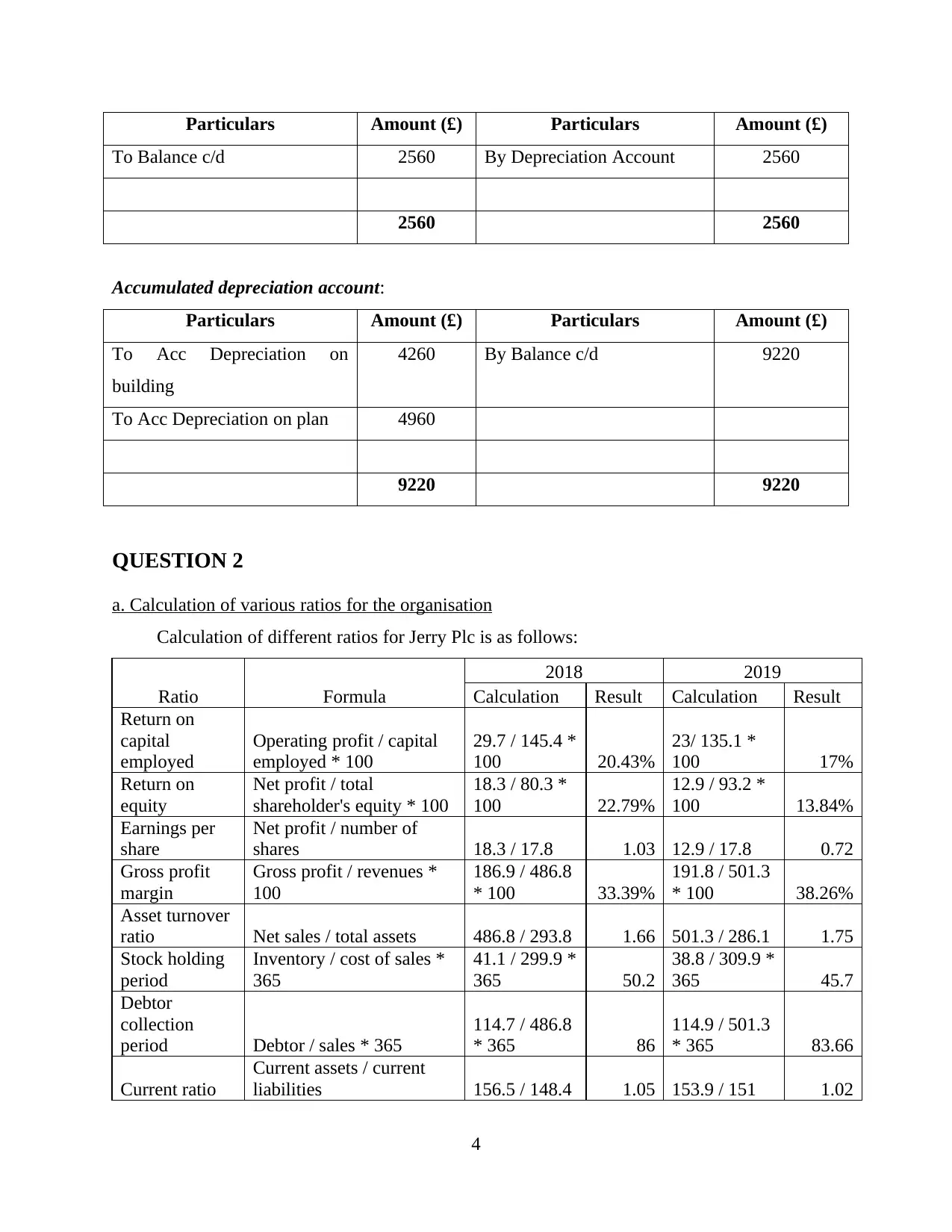
Particulars Amount (£) Particulars Amount (£)
To Balance c/d 2560 By Depreciation Account 2560
2560 2560
Accumulated depreciation account:
Particulars Amount (£) Particulars Amount (£)
To Acc Depreciation on
building
4260 By Balance c/d 9220
To Acc Depreciation on plan 4960
9220 9220
QUESTION 2
a. Calculation of various ratios for the organisation
Calculation of different ratios for Jerry Plc is as follows:
Ratio Formula
2018 2019
Calculation Result Calculation Result
Return on
capital
employed
Operating profit / capital
employed * 100
29.7 / 145.4 *
100 20.43%
23/ 135.1 *
100 17%
Return on
equity
Net profit / total
shareholder's equity * 100
18.3 / 80.3 *
100 22.79%
12.9 / 93.2 *
100 13.84%
Earnings per
share
Net profit / number of
shares 18.3 / 17.8 1.03 12.9 / 17.8 0.72
Gross profit
margin
Gross profit / revenues *
100
186.9 / 486.8
* 100 33.39%
191.8 / 501.3
* 100 38.26%
Asset turnover
ratio Net sales / total assets 486.8 / 293.8 1.66 501.3 / 286.1 1.75
Stock holding
period
Inventory / cost of sales *
365
41.1 / 299.9 *
365 50.2
38.8 / 309.9 *
365 45.7
Debtor
collection
period Debtor / sales * 365
114.7 / 486.8
* 365 86
114.9 / 501.3
* 365 83.66
Current ratio
Current assets / current
liabilities 156.5 / 148.4 1.05 153.9 / 151 1.02
4
To Balance c/d 2560 By Depreciation Account 2560
2560 2560
Accumulated depreciation account:
Particulars Amount (£) Particulars Amount (£)
To Acc Depreciation on
building
4260 By Balance c/d 9220
To Acc Depreciation on plan 4960
9220 9220
QUESTION 2
a. Calculation of various ratios for the organisation
Calculation of different ratios for Jerry Plc is as follows:
Ratio Formula
2018 2019
Calculation Result Calculation Result
Return on
capital
employed
Operating profit / capital
employed * 100
29.7 / 145.4 *
100 20.43%
23/ 135.1 *
100 17%
Return on
equity
Net profit / total
shareholder's equity * 100
18.3 / 80.3 *
100 22.79%
12.9 / 93.2 *
100 13.84%
Earnings per
share
Net profit / number of
shares 18.3 / 17.8 1.03 12.9 / 17.8 0.72
Gross profit
margin
Gross profit / revenues *
100
186.9 / 486.8
* 100 33.39%
191.8 / 501.3
* 100 38.26%
Asset turnover
ratio Net sales / total assets 486.8 / 293.8 1.66 501.3 / 286.1 1.75
Stock holding
period
Inventory / cost of sales *
365
41.1 / 299.9 *
365 50.2
38.8 / 309.9 *
365 45.7
Debtor
collection
period Debtor / sales * 365
114.7 / 486.8
* 365 86
114.9 / 501.3
* 365 83.66
Current ratio
Current assets / current
liabilities 156.5 / 148.4 1.05 153.9 / 151 1.02
4
⊘ This is a preview!⊘
Do you want full access?
Subscribe today to unlock all pages.

Trusted by 1+ million students worldwide
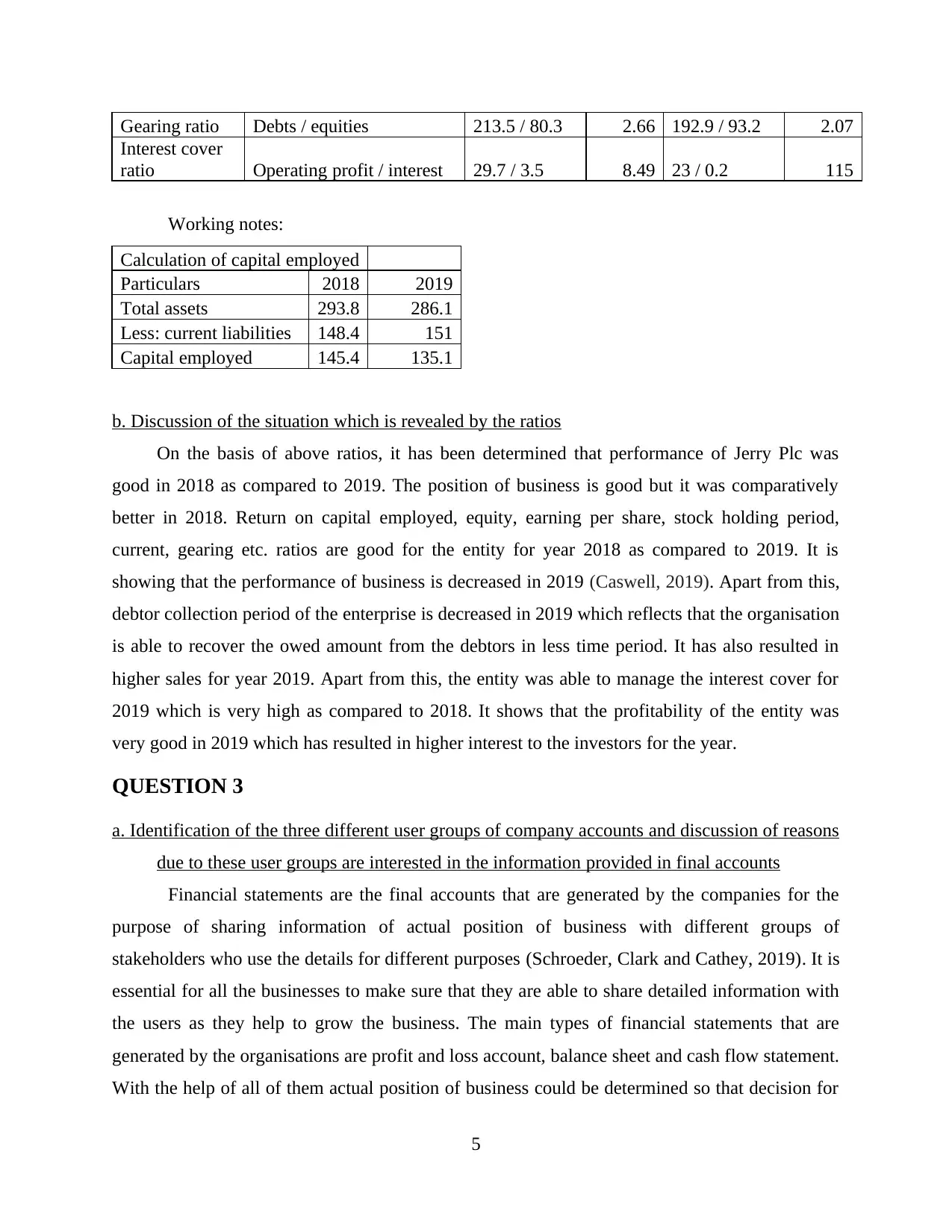
Gearing ratio Debts / equities 213.5 / 80.3 2.66 192.9 / 93.2 2.07
Interest cover
ratio Operating profit / interest 29.7 / 3.5 8.49 23 / 0.2 115
Working notes:
Calculation of capital employed
Particulars 2018 2019
Total assets 293.8 286.1
Less: current liabilities 148.4 151
Capital employed 145.4 135.1
b. Discussion of the situation which is revealed by the ratios
On the basis of above ratios, it has been determined that performance of Jerry Plc was
good in 2018 as compared to 2019. The position of business is good but it was comparatively
better in 2018. Return on capital employed, equity, earning per share, stock holding period,
current, gearing etc. ratios are good for the entity for year 2018 as compared to 2019. It is
showing that the performance of business is decreased in 2019 (Caswell, 2019). Apart from this,
debtor collection period of the enterprise is decreased in 2019 which reflects that the organisation
is able to recover the owed amount from the debtors in less time period. It has also resulted in
higher sales for year 2019. Apart from this, the entity was able to manage the interest cover for
2019 which is very high as compared to 2018. It shows that the profitability of the entity was
very good in 2019 which has resulted in higher interest to the investors for the year.
QUESTION 3
a. Identification of the three different user groups of company accounts and discussion of reasons
due to these user groups are interested in the information provided in final accounts
Financial statements are the final accounts that are generated by the companies for the
purpose of sharing information of actual position of business with different groups of
stakeholders who use the details for different purposes (Schroeder, Clark and Cathey, 2019). It is
essential for all the businesses to make sure that they are able to share detailed information with
the users as they help to grow the business. The main types of financial statements that are
generated by the organisations are profit and loss account, balance sheet and cash flow statement.
With the help of all of them actual position of business could be determined so that decision for
5
Interest cover
ratio Operating profit / interest 29.7 / 3.5 8.49 23 / 0.2 115
Working notes:
Calculation of capital employed
Particulars 2018 2019
Total assets 293.8 286.1
Less: current liabilities 148.4 151
Capital employed 145.4 135.1
b. Discussion of the situation which is revealed by the ratios
On the basis of above ratios, it has been determined that performance of Jerry Plc was
good in 2018 as compared to 2019. The position of business is good but it was comparatively
better in 2018. Return on capital employed, equity, earning per share, stock holding period,
current, gearing etc. ratios are good for the entity for year 2018 as compared to 2019. It is
showing that the performance of business is decreased in 2019 (Caswell, 2019). Apart from this,
debtor collection period of the enterprise is decreased in 2019 which reflects that the organisation
is able to recover the owed amount from the debtors in less time period. It has also resulted in
higher sales for year 2019. Apart from this, the entity was able to manage the interest cover for
2019 which is very high as compared to 2018. It shows that the profitability of the entity was
very good in 2019 which has resulted in higher interest to the investors for the year.
QUESTION 3
a. Identification of the three different user groups of company accounts and discussion of reasons
due to these user groups are interested in the information provided in final accounts
Financial statements are the final accounts that are generated by the companies for the
purpose of sharing information of actual position of business with different groups of
stakeholders who use the details for different purposes (Schroeder, Clark and Cathey, 2019). It is
essential for all the businesses to make sure that they are able to share detailed information with
the users as they help to grow the business. The main types of financial statements that are
generated by the organisations are profit and loss account, balance sheet and cash flow statement.
With the help of all of them actual position of business could be determined so that decision for
5
Paraphrase This Document
Need a fresh take? Get an instant paraphrase of this document with our AI Paraphraser
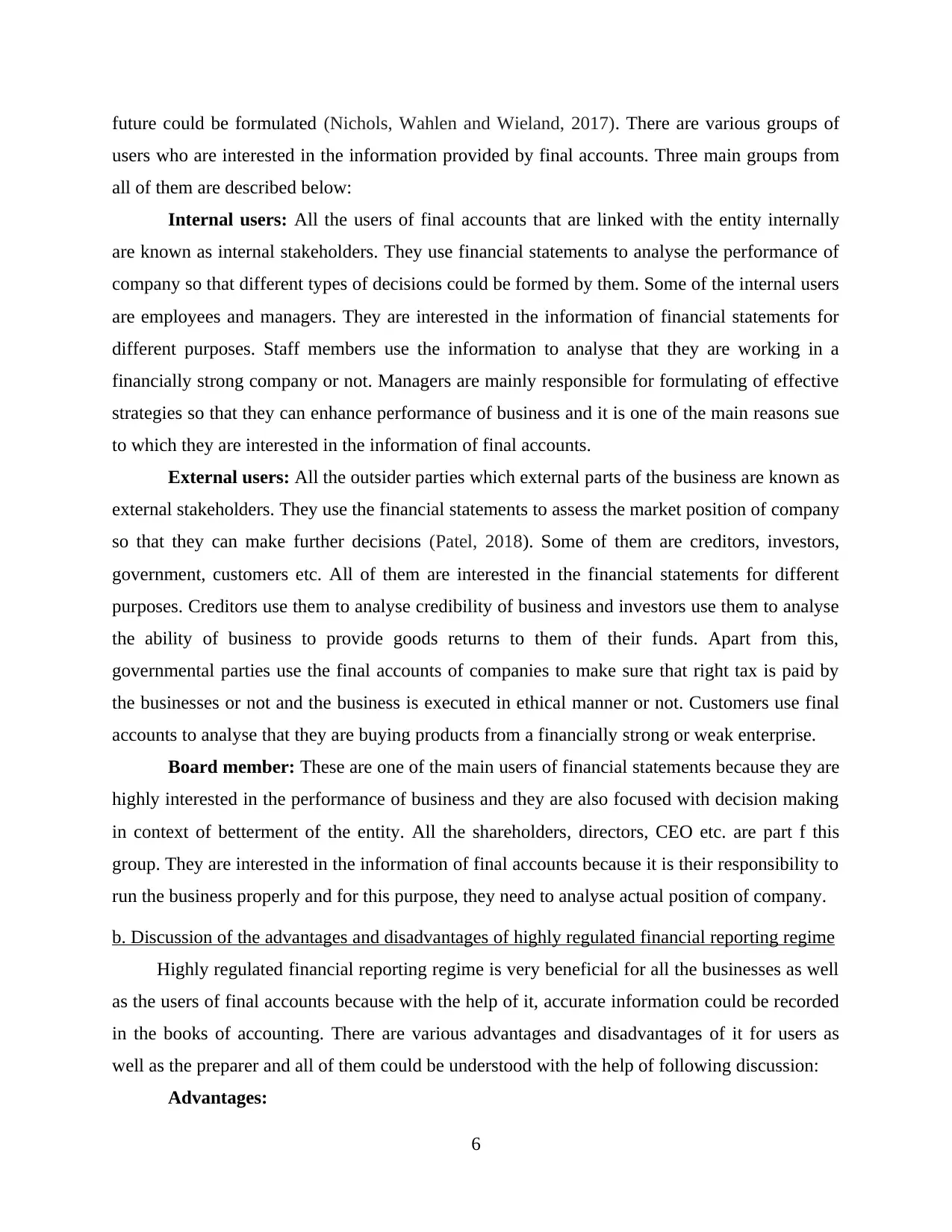
future could be formulated (Nichols, Wahlen and Wieland, 2017). There are various groups of
users who are interested in the information provided by final accounts. Three main groups from
all of them are described below:
Internal users: All the users of final accounts that are linked with the entity internally
are known as internal stakeholders. They use financial statements to analyse the performance of
company so that different types of decisions could be formed by them. Some of the internal users
are employees and managers. They are interested in the information of financial statements for
different purposes. Staff members use the information to analyse that they are working in a
financially strong company or not. Managers are mainly responsible for formulating of effective
strategies so that they can enhance performance of business and it is one of the main reasons sue
to which they are interested in the information of final accounts.
External users: All the outsider parties which external parts of the business are known as
external stakeholders. They use the financial statements to assess the market position of company
so that they can make further decisions (Patel, 2018). Some of them are creditors, investors,
government, customers etc. All of them are interested in the financial statements for different
purposes. Creditors use them to analyse credibility of business and investors use them to analyse
the ability of business to provide goods returns to them of their funds. Apart from this,
governmental parties use the final accounts of companies to make sure that right tax is paid by
the businesses or not and the business is executed in ethical manner or not. Customers use final
accounts to analyse that they are buying products from a financially strong or weak enterprise.
Board member: These are one of the main users of financial statements because they are
highly interested in the performance of business and they are also focused with decision making
in context of betterment of the entity. All the shareholders, directors, CEO etc. are part f this
group. They are interested in the information of final accounts because it is their responsibility to
run the business properly and for this purpose, they need to analyse actual position of company.
b. Discussion of the advantages and disadvantages of highly regulated financial reporting regime
Highly regulated financial reporting regime is very beneficial for all the businesses as well
as the users of final accounts because with the help of it, accurate information could be recorded
in the books of accounting. There are various advantages and disadvantages of it for users as
well as the preparer and all of them could be understood with the help of following discussion:
Advantages:
6
users who are interested in the information provided by final accounts. Three main groups from
all of them are described below:
Internal users: All the users of final accounts that are linked with the entity internally
are known as internal stakeholders. They use financial statements to analyse the performance of
company so that different types of decisions could be formed by them. Some of the internal users
are employees and managers. They are interested in the information of financial statements for
different purposes. Staff members use the information to analyse that they are working in a
financially strong company or not. Managers are mainly responsible for formulating of effective
strategies so that they can enhance performance of business and it is one of the main reasons sue
to which they are interested in the information of final accounts.
External users: All the outsider parties which external parts of the business are known as
external stakeholders. They use the financial statements to assess the market position of company
so that they can make further decisions (Patel, 2018). Some of them are creditors, investors,
government, customers etc. All of them are interested in the financial statements for different
purposes. Creditors use them to analyse credibility of business and investors use them to analyse
the ability of business to provide goods returns to them of their funds. Apart from this,
governmental parties use the final accounts of companies to make sure that right tax is paid by
the businesses or not and the business is executed in ethical manner or not. Customers use final
accounts to analyse that they are buying products from a financially strong or weak enterprise.
Board member: These are one of the main users of financial statements because they are
highly interested in the performance of business and they are also focused with decision making
in context of betterment of the entity. All the shareholders, directors, CEO etc. are part f this
group. They are interested in the information of final accounts because it is their responsibility to
run the business properly and for this purpose, they need to analyse actual position of company.
b. Discussion of the advantages and disadvantages of highly regulated financial reporting regime
Highly regulated financial reporting regime is very beneficial for all the businesses as well
as the users of final accounts because with the help of it, accurate information could be recorded
in the books of accounting. There are various advantages and disadvantages of it for users as
well as the preparer and all of them could be understood with the help of following discussion:
Advantages:
6
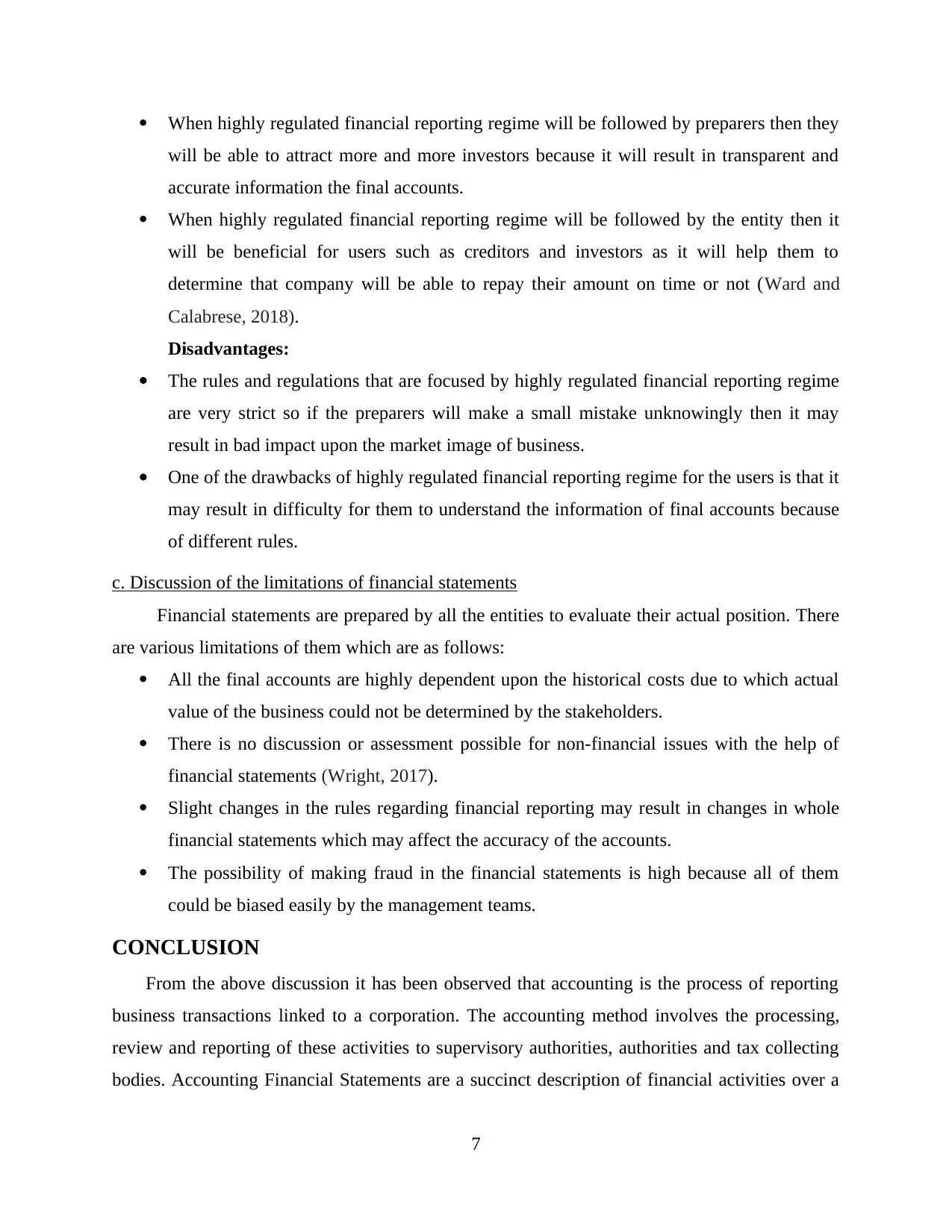
When highly regulated financial reporting regime will be followed by preparers then they
will be able to attract more and more investors because it will result in transparent and
accurate information the final accounts.
When highly regulated financial reporting regime will be followed by the entity then it
will be beneficial for users such as creditors and investors as it will help them to
determine that company will be able to repay their amount on time or not (Ward and
Calabrese, 2018).
Disadvantages:
The rules and regulations that are focused by highly regulated financial reporting regime
are very strict so if the preparers will make a small mistake unknowingly then it may
result in bad impact upon the market image of business.
One of the drawbacks of highly regulated financial reporting regime for the users is that it
may result in difficulty for them to understand the information of final accounts because
of different rules.
c. Discussion of the limitations of financial statements
Financial statements are prepared by all the entities to evaluate their actual position. There
are various limitations of them which are as follows:
All the final accounts are highly dependent upon the historical costs due to which actual
value of the business could not be determined by the stakeholders.
There is no discussion or assessment possible for non-financial issues with the help of
financial statements (Wright, 2017).
Slight changes in the rules regarding financial reporting may result in changes in whole
financial statements which may affect the accuracy of the accounts.
The possibility of making fraud in the financial statements is high because all of them
could be biased easily by the management teams.
CONCLUSION
From the above discussion it has been observed that accounting is the process of reporting
business transactions linked to a corporation. The accounting method involves the processing,
review and reporting of these activities to supervisory authorities, authorities and tax collecting
bodies. Accounting Financial Statements are a succinct description of financial activities over a
7
will be able to attract more and more investors because it will result in transparent and
accurate information the final accounts.
When highly regulated financial reporting regime will be followed by the entity then it
will be beneficial for users such as creditors and investors as it will help them to
determine that company will be able to repay their amount on time or not (Ward and
Calabrese, 2018).
Disadvantages:
The rules and regulations that are focused by highly regulated financial reporting regime
are very strict so if the preparers will make a small mistake unknowingly then it may
result in bad impact upon the market image of business.
One of the drawbacks of highly regulated financial reporting regime for the users is that it
may result in difficulty for them to understand the information of final accounts because
of different rules.
c. Discussion of the limitations of financial statements
Financial statements are prepared by all the entities to evaluate their actual position. There
are various limitations of them which are as follows:
All the final accounts are highly dependent upon the historical costs due to which actual
value of the business could not be determined by the stakeholders.
There is no discussion or assessment possible for non-financial issues with the help of
financial statements (Wright, 2017).
Slight changes in the rules regarding financial reporting may result in changes in whole
financial statements which may affect the accuracy of the accounts.
The possibility of making fraud in the financial statements is high because all of them
could be biased easily by the management teams.
CONCLUSION
From the above discussion it has been observed that accounting is the process of reporting
business transactions linked to a corporation. The accounting method involves the processing,
review and reporting of these activities to supervisory authorities, authorities and tax collecting
bodies. Accounting Financial Statements are a succinct description of financial activities over a
7
⊘ This is a preview!⊘
Do you want full access?
Subscribe today to unlock all pages.

Trusted by 1+ million students worldwide
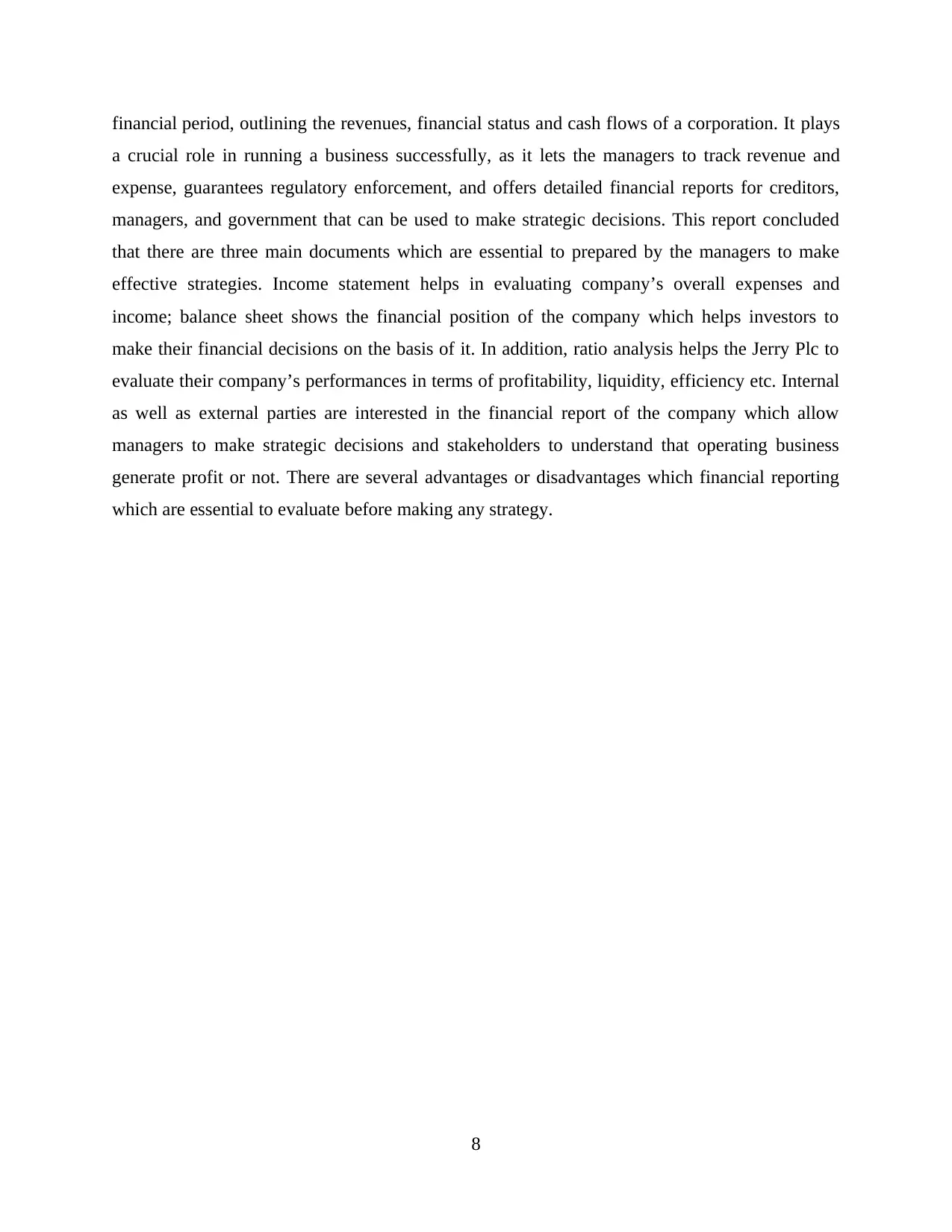
financial period, outlining the revenues, financial status and cash flows of a corporation. It plays
a crucial role in running a business successfully, as it lets the managers to track revenue and
expense, guarantees regulatory enforcement, and offers detailed financial reports for creditors,
managers, and government that can be used to make strategic decisions. This report concluded
that there are three main documents which are essential to prepared by the managers to make
effective strategies. Income statement helps in evaluating company’s overall expenses and
income; balance sheet shows the financial position of the company which helps investors to
make their financial decisions on the basis of it. In addition, ratio analysis helps the Jerry Plc to
evaluate their company’s performances in terms of profitability, liquidity, efficiency etc. Internal
as well as external parties are interested in the financial report of the company which allow
managers to make strategic decisions and stakeholders to understand that operating business
generate profit or not. There are several advantages or disadvantages which financial reporting
which are essential to evaluate before making any strategy.
8
a crucial role in running a business successfully, as it lets the managers to track revenue and
expense, guarantees regulatory enforcement, and offers detailed financial reports for creditors,
managers, and government that can be used to make strategic decisions. This report concluded
that there are three main documents which are essential to prepared by the managers to make
effective strategies. Income statement helps in evaluating company’s overall expenses and
income; balance sheet shows the financial position of the company which helps investors to
make their financial decisions on the basis of it. In addition, ratio analysis helps the Jerry Plc to
evaluate their company’s performances in terms of profitability, liquidity, efficiency etc. Internal
as well as external parties are interested in the financial report of the company which allow
managers to make strategic decisions and stakeholders to understand that operating business
generate profit or not. There are several advantages or disadvantages which financial reporting
which are essential to evaluate before making any strategy.
8
Paraphrase This Document
Need a fresh take? Get an instant paraphrase of this document with our AI Paraphraser
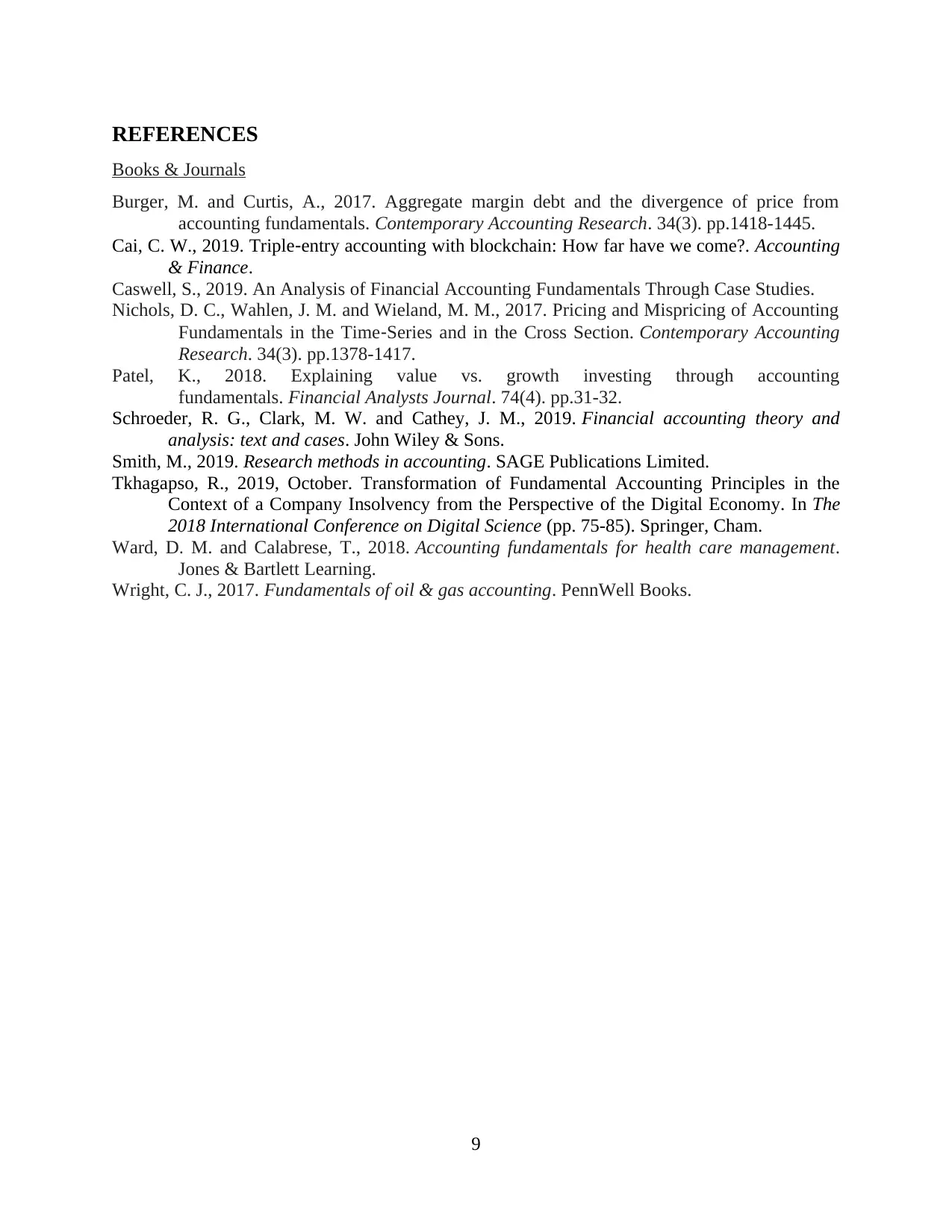
REFERENCES
Books & Journals
Burger, M. and Curtis, A., 2017. Aggregate margin debt and the divergence of price from
accounting fundamentals. Contemporary Accounting Research. 34(3). pp.1418-1445.
Cai, C. W., 2019. Triple‐entry accounting with blockchain: How far have we come?. Accounting
& Finance.
Caswell, S., 2019. An Analysis of Financial Accounting Fundamentals Through Case Studies.
Nichols, D. C., Wahlen, J. M. and Wieland, M. M., 2017. Pricing and Mispricing of Accounting
Fundamentals in the Time‐Series and in the Cross Section. Contemporary Accounting
Research. 34(3). pp.1378-1417.
Patel, K., 2018. Explaining value vs. growth investing through accounting
fundamentals. Financial Analysts Journal. 74(4). pp.31-32.
Schroeder, R. G., Clark, M. W. and Cathey, J. M., 2019. Financial accounting theory and
analysis: text and cases. John Wiley & Sons.
Smith, M., 2019. Research methods in accounting. SAGE Publications Limited.
Tkhagapso, R., 2019, October. Transformation of Fundamental Accounting Principles in the
Context of a Company Insolvency from the Perspective of the Digital Economy. In The
2018 International Conference on Digital Science (pp. 75-85). Springer, Cham.
Ward, D. M. and Calabrese, T., 2018. Accounting fundamentals for health care management.
Jones & Bartlett Learning.
Wright, C. J., 2017. Fundamentals of oil & gas accounting. PennWell Books.
9
Books & Journals
Burger, M. and Curtis, A., 2017. Aggregate margin debt and the divergence of price from
accounting fundamentals. Contemporary Accounting Research. 34(3). pp.1418-1445.
Cai, C. W., 2019. Triple‐entry accounting with blockchain: How far have we come?. Accounting
& Finance.
Caswell, S., 2019. An Analysis of Financial Accounting Fundamentals Through Case Studies.
Nichols, D. C., Wahlen, J. M. and Wieland, M. M., 2017. Pricing and Mispricing of Accounting
Fundamentals in the Time‐Series and in the Cross Section. Contemporary Accounting
Research. 34(3). pp.1378-1417.
Patel, K., 2018. Explaining value vs. growth investing through accounting
fundamentals. Financial Analysts Journal. 74(4). pp.31-32.
Schroeder, R. G., Clark, M. W. and Cathey, J. M., 2019. Financial accounting theory and
analysis: text and cases. John Wiley & Sons.
Smith, M., 2019. Research methods in accounting. SAGE Publications Limited.
Tkhagapso, R., 2019, October. Transformation of Fundamental Accounting Principles in the
Context of a Company Insolvency from the Perspective of the Digital Economy. In The
2018 International Conference on Digital Science (pp. 75-85). Springer, Cham.
Ward, D. M. and Calabrese, T., 2018. Accounting fundamentals for health care management.
Jones & Bartlett Learning.
Wright, C. J., 2017. Fundamentals of oil & gas accounting. PennWell Books.
9
1 out of 11
Related Documents
Your All-in-One AI-Powered Toolkit for Academic Success.
+13062052269
info@desklib.com
Available 24*7 on WhatsApp / Email
![[object Object]](/_next/static/media/star-bottom.7253800d.svg)
Unlock your academic potential
© 2024 | Zucol Services PVT LTD | All rights reserved.





